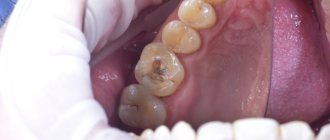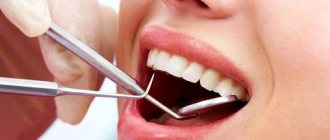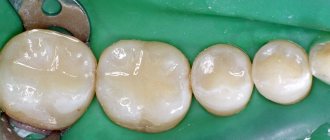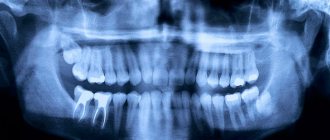Statistics from dental practice confirm the fact that light fillings are most often used and are gradually replacing other filling materials. This happens due to the objective advantages and high performance of fillings in practice.
Specialists from the network of dental clinics "LeaderStom" use light fillings of the latest developments and recommend this material for the restoration of crowns and the elimination of caries. If you notice the first signs of tooth decay and plan to eliminate it in a timely manner, then the LeaderStom clinic will be able to provide you with exactly the quality that meets the most progressive standards of dentistry.
Ceramic filling CEREC with a 50% discount
Heliocomposite composition
To understand how a light filling differs from a regular one, you need to know its composition and principle of operation. Light-curing fillings consist of a polymer matrix, glass-ceramic filler and bonding material. The principle of polymerization is a substance that breaks down into free radicals under the influence of ultraviolet rays. These radicals are responsible for the hardening of the material. The quality of stability and strength of the material depends on the size of the particles in the filler.
They can be: • mini-filled; • macro-, micro-filled; • nanohybrid.
The choice of material composition is determined by the dentist, based on hardness parameters or decorative priority.
The light filling performs the function of protecting tooth tissue from mechanical and chemical irritants. It prevents pathogenic microbes from entering the tooth and withstands significant daily loads. Therefore, the requirements for the quality of filling material are very high, and the light filling fully lives up to the expectations placed on it.
Chemical and light curing fillings
Chemically cured fillings (“chemical” fillings) harden as a result of a chemical reaction of components that are mixed immediately before the filling is placed.
Classic glass ionomer cement
(chemical curing) is a “powder-liquid” system. The powder is aluminofluorosilicate glass with a high fluorine content, and the liquid is an aqueous solution of polyacrylic acid. After mixing, the initial stage of hardening lasts about 7 minutes, the completion of the formation of the structure occurs after 2-3 weeks. The process can be accelerated by using various additives. Glass ionomer cements have the property of prolonged fluoride release, which prevents secondary caries. In addition, glass ionomer cements can absorb fluoride ions when used with fluoride toothpaste. Modern glass ionomer cements have chemical adhesion (affinity) to hard dental tissues and composite materials and good marginal fit.
Chemically cured composites
– another class of filling materials. By definition, a composite material is a mixture of several dissimilar components. In the case of dental composites, it is a mixture of filler (usually inorganic) and an organic matrix, and the filler content is quite significant (at least 30% by volume; with a lower filler content, the material is usually classified as a “low-filled polymer”). They are “paste-paste” or “powder-liquid” systems. The main advantage provided by filling teeth using such dental composites is uniform curing, regardless of the depth of the cavity and the size of the filling.
The most modern method for filling cured teeth is the method using light-curing composite materials (“light composites”, “light fillings”, “gel fillings”). These are materials in which a polymerization reaction occurs under the influence of ultraviolet light. Light-curing composite materials have a number of advantages compared to chemically curing materials:
- Before hardening the filling (irradiation with a special ultraviolet lamp), the dentist has the opportunity to more accurately restore the shape and relief of even a severely damaged tooth;
- the components of the light-curing filling material react with each other without the formation of by-products, which leads to a durable structure;
- You can choose the desired shade and transparency of the filling and achieve the desired cosmetic effect.
It should be taken into account that accelerated light polymerization (2-40 seconds) creates greater internal stress in the material in a light filling than in chemically cured composites. This can lead to cracks, so the filling is formed layer-by-layer, which also reduces polymerization shrinkage. Another feature of the installation of light fillings is the need for a reliable connection between the hydrophobic composite and hydrophilic (wet) dentin. Unlike glass ionomer cements, composites do not have chemical adhesion to hard tooth tissues. To ensure adhesion, before installing a light filling, special adhesive systems (etching gels, primers, bonds) are used, which hermetically seal (fill) all micro-holes of the tooth, or special insulating gaskets. As a result, the mechanical and chemical adhesion of the filling material (composite) to the tooth tissue increases significantly.
The advent of light-curing composite materials and modern adhesive systems has led to new principles for preparing teeth for filling. The strong connection of composite materials with enamel and dentin (connection strength 17-20 MPa and above) allows you to remove only damaged tooth tissue. Healthy tissue is removed only to create minimal access to the lesion, whereas when using filling materials of previous generations, healthy tissue was also removed (in order to create a cavity of a certain shape). The filling, instead of resting on the prepared dental tissues, has become supportive and strengthens the dental tissues. Such a filling takes on the role of lost supporting structures and allows the use of minimal intervention techniques (gentle preparation of cavities and defects in dental tissue):
- preparation focused on a specific defect shape (for example, a spherical cavity);
- removing only destroyed, non-viable dentin and leaving the enamel without dentin support (removed dentin is replaced with a composite that has the elasticity of dentin and absorbs excess loads);
- adhesive correction of the filling in case of delamination, chipping without complete replacement (which can lead to additional loss of dental tissue).
Make an appointment with the best dentists in Moscow!
Durability
The average lifespan of light seals is about five years. However, in practice, they can keep the tooth intact for much longer. For greater durability of the filling, dentists at the LeaderStom clinic recommend carefully monitoring oral hygiene, proper nutrition and sufficient calcium intake into the body.
Stable fastening of the light filling is achieved through an adhesive system - a special light-sensitive liquid that is used to treat the tooth walls. Performing the function of “glue”, it so firmly connects the photopolymer material with the tooth enamel that subsequently a chemical calcium exchange begins to occur between these tissues.
Features of light seals
Light filling is considered a more modern tool for caries treatment. The exposure time to ultraviolet rays of a special lamp, which is used to harden light fillings, is no more than 30-40 seconds; If exposure to the UV lamp is prolonged, the filling will develop cracks, which can damage the surrounding healthy tooth enamel or even destroy the tooth being filled.
In order to minimize possible harm to healthy tooth enamel, the filling composition of the light filling is applied in layers, each applied layer of filling is cured individually, layer by layer. Layer-by-layer curing of fillings also helps give the tooth the most natural appearance. It is also important that as a result of the layer-by-layer application of the component of the light-hardening filling, the dentist has the opportunity to most accurately adjust it to the desired shape. The light seal is easily selected by shade and is invisible to prying eyes. For anterior teeth, due to the presence of composites made of microparticles, light fillings differ from chemical fillings in their high aesthetic qualities. For molars, light fillings are made from composites with larger particles designed to withstand high chewing loads for greater resistance to abrasion.
Why are conventional fillings still used?
It would seem obvious that a light-curing filling is superior to chemical fillings in all cases - in terms of speed of installation and visibility. But, despite this, there are factors when the usual chemical filling, for some reasons, cannot be replaced with a light one: a light-curing filling cannot always be used to treat severely advanced cases of caries, when treatment of deeply affected areas of the tooth is required.
Light fillings are more suitable for surface application, and the price of a light filling is several times higher than the usual one, therefore, when filling back teeth, it is always more profitable for the patient to use conventional chemical fillings. In addition, one should not discount the fact that conventional fillings are more resistant to physical impact, for example, abrasion during chewing, so it is better to fill the chewing surfaces of molars with conventional chemical fillings, and light ones to be placed on the front teeth and the smile line.
Indications for the use of light fillings:
- carious tooth decay;
- dental injuries with chipping;
- correction of damaged teeth if the crown part is preserved more than 50%;
- small and medium enamel defects, light-curing fillings allow you to create small patches for small areas of enamel where chemical fillings will not hold.
Disadvantages of light fillings:
- Possible insufficient polymerization, approximately 60-70%, this factor can have a negative impact on the shade of the filling;
- shrinkage of the filling (when exposed to light, the composite of the light seal may shrink, as a result of which the light seal has a risk of peeling off).
The most famous and frequently used manufacturers of light-curing compounds
Degussa (Germany); Noritake (Japan); Dipol (USA); GC America (USA); Fuji (Japan); Bisco (USA); Kerr (USA).
Biological compatibility
It is known that filling material such as amalgam, which was used several years ago for dental treatment, contains mercury in its composition. Another material, glass ionomer cement, is also used in dentistry, but contains fluoride, which recent research suggests may be harmful to the pineal gland. In this range of filling materials, light fillings are distinguished by their maximum biological compatibility. They do not emit toxic substances, do not destroy the tooth crown (as cement composites do due to higher hardness than the tooth), and have optimal expansion-compression characteristics under temperature changes.
How to care for fillings?
As a rule, after installing a filling on the dental tissue, it is forbidden to eat for a certain period of time. The duration of this interval depends on what type of filling material was used for the filling and can be either several minutes or several hours. This medical recommendation should not be ignored.
It should be noted that the filling will serve its owner for quite a long time if he strictly follows all hygiene rules of the oral cavity, as well as regularly undergoes professional cleaning by a dental hygienist.
It is necessary to remove foods that can harm the restoration from the diet. These products include hard candies called “taffy”, grilled fruit, seeds, and nuts. Do not lose sight of the fact that the seal has a warranty period. For this reason, after a specific period of time, the tooth must be refilled.
After installing a filling, some patients find it painful to bite due to hypersensitivity of the dental tissue. This painful discomfort is called “post-filling pain.” Such pain usually goes away within a short period of time without any painkillers. Hypersensitivity is usually provoked by overdrying and irritation of dentin during the etching of the oral cavity, a violation of the tightness of the filling due to its shrinkage, and the negative effect of lamps on the dental pulp.
Dental tissue may become sore after treatment for complex caries or due to an allergy to the filling material.
Shevchenko Irina Nikolaevna
Dentist-therapist
Business hours
- Wed10:00 - 21:00
Fri10:00 – 21:00
Make an appointment
Mironova Maria Vitalievna
Dentist-therapist
Business hours
- Tue14:00 – 21:00
Thu10:00 – 14:00
Make an appointment
High aesthetic characteristics
The aesthetic factor is especially important when eliminating caries on the front teeth. The material of the photo light seal lends itself perfectly to final processing: grinding and polishing. And the color set provided by raw material manufacturers includes the full range of possible shades of tooth enamel. This fact allows you to accurately imitate the natural color of the tooth in the absence of boundaries between the enamel tissue and the filling. Even after several years of use, it can be quite difficult to determine this boundary, and immediately after tooth restoration it is simply impossible.
The effect of preserving tooth color gradations is possible thanks to the use of the latest layer-by-layer application technologies. The so-called polychrome filling uses more than two color components: darker at the base of the tooth and lighter towards the cusps. The most modern compositions of filling materials used in the LeaderStorm clinic were developed using nanotechnology. They allow you to achieve maximum aesthetic effect when restoring a tooth.
There are rare exceptions when priority is given to chemical composites. For example, when installing the material in a place that is difficult to reach for ultraviolet radiation. If a tooth restoration is carried out with a light filling, then the light polymerization will not be effective and the composite will not harden properly. In such situations, a chemically cured material is recommended.
All of the above advantages of light seals, reviews are very positive, which is confirmed in practice.
What components are included in the photopolymer filling (light filling)?
In the process of producing photopolymer filling material, heliocomposite is used, which includes substances that can break down into radicals under the influence of ultraviolet light. This is precisely what underlies the polymerization of a light filling, and this is its main distinguishing feature from a chemical filling.
The photopolymer may contain various fillers, which affect the characteristics of the installed filling and determine its service life. In particular, light-curing fillings may contain the following components:
- Macrophiles are large inorganic components that make the filler highly durable, give it good optical qualities and have radiopacity. Also, the features of such particles include: resistance to polishing, increased roughness, color instability, the ability to carry out restoration of chewing teeth and the frontal group;
- Microphiles - they contain small particles that are easy to polish, have a durable glossy surface, have color stability, are famous for their excellent aesthetic characteristics and provide minimal abrasive wear. However, such components are characterized by low resistance to mechanical stress. Using microfilled components, it is possible to create facing plates and eliminate deficiencies that are not associated with carious lesions;
- Minifilled - represent a combination of the quality of microphiles and macrophiles, but are almost never used in real dental practice. They are characterized by low strength, are difficult to polish, have insufficient aesthetic properties, and have low resistance to excessive mechanical loads. Such fillers can be used to restore front and posterior teeth that have minor cavities;
- Nanohybrid - presented in the form of tiny particles that have universal characteristics, surpass all other components in aesthetics and mechanical strength, and can be used for a wide variety of filling purposes. In particular, nanohybrid composites are used to restore aesthetic defects of teeth.
What does a light-curing filling consist of?
Basically, for all types of fillings, a mixture of several materials is used. Composite light fillings have a complex chemical composition, which to some extent is why the cost of a light filling in Moscow is higher.
Components that make up the light seal:
- The heliocomposite base, breaking down into radicals under ultraviolet radiation, starts the process of polymerization (hardening) of the material itself.
- Filler – silicon dioxide, glass ceramics. The structure, color and area of application of the filling depend on it.
- Connecting elements.
Service cost
The question of how much it costs to install a light seal cannot be answered unambiguously. It all depends on the complexity of the treatment, the amount of work, and the amount of material used. In professional clinics, the price range ranges from 2,000 to 15,000 rubles. To this it is necessary to add the work of cleaning the affected area, the use of anesthesia and medications. In our dental center, a full calculation of the cost of the service is made at the first appointment. This way, the patient immediately knows the limits and can rationally calculate his budget.











